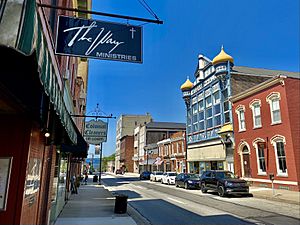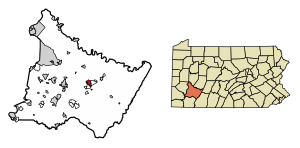Latrobe, Pennsylvania facts for kids
Quick facts for kids
Latrobe, Pennsylvania
|
|
|---|---|

Looking down Main Street in June 2021
|
|

Location of Latrobe in Westmoreland County, Pennsylvania
|
|
| Country | United States |
| State | Pennsylvania |
| County | Westmoreland |
| Settled | 1852 |
| Incorporated (borough) | May 24, 1854 |
| Incorporated (city) | 1999 |
| Government | |
| • Type | City council |
| Area | |
| • Total | 2.32 sq mi (6.00 km2) |
| • Land | 2.32 sq mi (6.00 km2) |
| • Water | 0.00 sq mi (0.00 km2) |
| Elevation | 997 ft (304 m) |
| Population
(2020)
|
|
| • Total | 8,060 |
| • Density | 3,480.14/sq mi (1,343.95/km2) |
| Time zone | UTC−5 (Eastern (EST)) |
| • Summer (DST) | UTC−4 (EDT) |
| ZIP Code |
15650
|
| Area code(s) | 724 |
| FIPS code | 42-41680 |
Latrobe is a city in Westmoreland County, Pennsylvania, United States. About 8,060 people lived there in 2020. It is part of the larger Pittsburgh metropolitan area. Latrobe is also close to Pennsylvania's beautiful Chestnut Ridge.
Latrobe is famous for a few cool things! It's the hometown of Fred Rogers, the beloved host of Mister Rogers' Neighborhood. It's also where golf legend Arnold Palmer grew up. Did you know the banana split was invented here in 1904? Plus, the Pittsburgh Steelers football team holds their summer training camp in Latrobe. The city became a borough in 1854 and a city in 1999. Eric J. Bartels is the current mayor.
Contents
History of Latrobe
In 1852, a civil engineer named Oliver Barnes planned out the community. It officially became the Borough of Latrobe in 1854. Barnes named the town after his good friend, Benjamin Henry Latrobe II. Benjamin Henry Latrobe II was a chief engineer for a railroad company. His father, also named Benjamin Henry Latrobe, was a famous architect. He helped rebuild the United States Capitol building after the War of 1812.
Latrobe's location was great for industry. It was right along the Pennsylvania Railroad route. This helped the town grow into an important center for businesses. Another railroad, the Ligonier Valley Railroad, also served Latrobe from 1877 to 1952.
The Banana Split Story
Latrobe is proud to be the birthplace of the banana split! In 1904, a young man named David Evans Strickler created this yummy dessert. He worked at a pharmacy that later became Strickler's Drug Store. In 2004, a national ice cream group officially said Latrobe was where the banana split began. The city even has a fun festival every year to celebrate this sweet treat!
Historic Buildings
Latrobe has two special places listed on the National Register of Historic Places. These are important sites that are protected because of their history.
- The Pennsylvania Railroad Station was built in 1903. You can find it at 325 McKinley Avenue.
- The Citizens National Bank of Latrobe building was built in 1926. It's located at 816 Ligonier Street.
An old fortress from the 1700s, called Fort Sloan, is also in Latrobe. It was built by early British settlers. Today, it is a private home.
Early Professional Football
From 1895 to 1909, Latrobe was home to one of the very first professional American football teams. This team was called the Latrobe Athletic Association.
A player named John Brallier was on this team. He was one of the first football players to openly say he was paid to play. In 1895, he got $10 and his travel costs to play for Latrobe. They won that game 12–0 against the Jeannette Athletic Club. For a long time, people thought Brallier was the first professional player. But later, it was found that another player, Pudge Heffelfinger, was paid to play three years earlier.
In 1897, Latrobe's team made history again. They were the first football team to play a whole season with only professional players. The team had many top players of that time.
Brewing History
The Latrobe Brewing Company started in 1939. It became one of the biggest breweries in the United States. They were famous for making Rolling Rock beer.
In 2006, another company bought the Rolling Rock brand. However, they did not buy the Latrobe brewery itself. Later, the City Brewing Company bought the brewery. Today, the plant brews Iron City Beer and other brands.
Geography
Latrobe is located at 40°18′54″N 79°22′52″W / 40.31500°N 79.38111°W. The city covers about 2.3 square miles (6.0 square kilometers) of land. Latrobe has a climate with hot summers. The average temperature in January is about 28.9°F (-1.7°C). In July, it's around 72.0°F (22.2°C).
Nearby Areas
Latrobe shares its borders with other towns and townships. To the north, northwest, east, and southeast, it borders Derry Township. To the west and southwest, it borders Unity Township.
Population Facts
| Historical population | |||
|---|---|---|---|
| Census | Pop. | %± | |
| 1860 | 758 | — | |
| 1870 | 1,127 | 48.7% | |
| 1880 | 1,815 | 61.0% | |
| 1890 | 3,589 | 97.7% | |
| 1900 | 4,614 | 28.6% | |
| 1910 | 8,777 | 90.2% | |
| 1920 | 9,484 | 8.1% | |
| 1930 | 10,644 | 12.2% | |
| 1940 | 11,111 | 4.4% | |
| 1950 | 11,811 | 6.3% | |
| 1960 | 11,932 | 1.0% | |
| 1970 | 11,749 | −1.5% | |
| 1980 | 10,799 | −8.1% | |
| 1990 | 9,265 | −14.2% | |
| 2000 | 8,944 | −3.5% | |
| 2010 | 8,338 | −6.8% | |
| 2020 | 8,060 | −3.3% | |
In 2010, there were 8,338 people living in Latrobe. There were 3,786 households. About 26% of these households had children under 18 living with them. The average household had 2.22 people.
The median age in the city was 42 years old. This means half the people were younger than 42, and half were older. The average income for a household was about $33,268.
Transportation
Latrobe has several ways to get around and connect to other places.
- Arnold Palmer Regional Airport: This airport used to be called Westmoreland County Airport. It helps people travel by air.
- Latrobe (Amtrak station): This is a train station for Amtrak trains.
- Westmoreland Transit: This service offers local bus routes. It also has commuter routes to bigger cities like Pittsburgh and Johnstown.
Famous People from Latrobe
Many interesting people have connections to Latrobe!
- Mary Temple Bayard (1853–1916): A writer and journalist.
- John Brallier (1876–1960): One of the first openly paid professional football players.
- Victory Brinker: An amazing opera singer who became famous at just nine years old.
- Walt Corey: A player and coach in the National Football League.
- Keith Ferrazzi: An author and business person.
- Dennis Ferry: A trumpeter for a famous orchestra in Switzerland.
- Gregory S. Forbes: A meteorologist and expert on severe weather for The Weather Channel.
- Hanna Green: A talented track and field runner.
- Kevin Guskiewicz: The Chancellor of the University of North Carolina at Chapel Hill.
- Francis J. Harvey: Served as the United States Secretary of the Army.
- Daniel Lentz: A composer of classical and electronic music.
- Chris Lightcap: A jazz bassist.
- Jackie Mason: A comedian and actor.
- Arnold Palmer: A legendary professional golfer and member of the World Golf Hall of Fame.
- Fred Rogers: The kind host of the PBS show Mister Rogers' Neighborhood. He lived in Latrobe until high school.
- Eliza Kennedy Smith: A strong supporter of women's right to vote and a community activist.
- Andy Stynchula: A player in the National Football League.
- Scott Warner: A designer who works with lighting.
- Boniface Wimmer: A monk who founded Saint Vincent Archabbey nearby in 1846.
Images for kids
See also
 In Spanish: Latrobe (Pensilvania) para niños
In Spanish: Latrobe (Pensilvania) para niños







